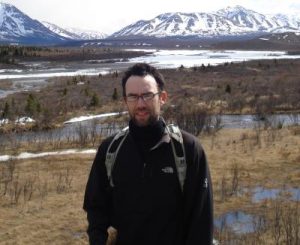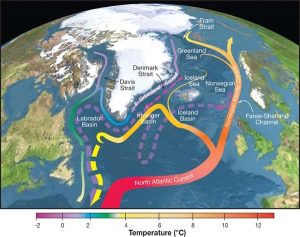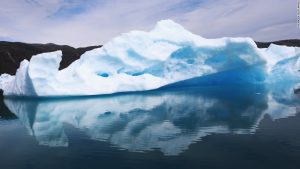Melting glaciers lead to a hotter world. Episodes of glaciers and ice falling into the sea make our weather one year very different from the next. New Zealand ice-expert Nicholas Golledge joins us. But first, from California Dr. Robert Allen reveals pollution has hidden up to half a degree C. of warming. I think the two degree supposed “safe” line is already in the rear-view mirror. This is Radio Ecoshock. Prepare to live in a very different world.
Listen to or download this Radio Ecoshock show in CD Quality (57 MB) or Lo-Fi (14 MB)
It is already pretty strange. Talking with CKUW radio in Winnipeg Canada, a weak Jet Stream left the freezer door open. After a few weeks getting down to 39.9 degrees C, about the same in Fahrenheit, folks there are ready for some global warming. Where Tasmania was super hot with giant fires, it snowed in the highlands a few days later, just like the strange snow in Hawaii last week. California has been drowning with rain, which is mega-snow in the mountains, while the slopes burned out in last years fires break into rivers of mud taking out homes and highways. Back in Australia, following that brutal heat, a “mega-river” up to 37 miles wide, 60 kilometers, suddenly appeared in the bed of a smallish river in Queensland. Folks in the Swiss and Austrian Alps are digging out mountains of snow. That is all during “neutral ocean conditions, but scientists have just announced a new tilt: an El Nino has formed in the Eastern Pacific. That usually leads to more record hot weather around the world. Prediction is hard. The future has been destabilized.
*******************************************************************************************************************
Anyone can contribute to keeping this program/blog going, by making a donation large or small here.
********************************************************************************************************************
UP TO HALF A DEGREE MORE WARMING HIDDEN IN POLLUTION – DR. ROBERT ALLEN
You can’t see them, but you are surrounded by billions of tiny particles. When bits of dust or droplets hang in the air, scientists call them “aerosols“. In the atmosphere, aerosols protect us a little from being too hot. They hide some of the warming we have already created. As smog, they kill us by the millions every year. What happens to aerosols as the world heats up even more? We need to know.
Our guest Dr. Robert Allen wades into what may be one of the most complex questions of science. After getting his Pd.D. in Atmosphere, Ocean and Climate Dynamics at Yale, Robert was a Postdoctoral Scholar at various places, including at the Scripps Institution of Oceanography. I called Dr. Allen about his new paper “Enhanced land–sea warming contrast elevates aerosol pollution in a warmer world“. It was published February 4th, 2019 in the prestigious journal Nature Climate Change.

Dr. Robert J. Allen, UC Riverside
The composition of these little drops or flecks is not simple. There are so many things that could be up there, scientists talk about aerosol “species” and “populations”. I’ve seen a greatly-magnified photo of a tiny solid piece which looked like an asteroid. It had other things smeared on it, like maybe pesticides or materials from car exhausts.
When sunlight arrives on Earth, some of it bounces and radiates back out into space. But some of the Sun’s energy is held within the Earth’s atmosphere by greenhouse gases like carbon dioxide. A significant portion of the Sun’s light never reaches the surface, because it strikes aerosol particles first.
There is a stunning statement in the introduction, which says “aerosols cause a net cooling effect, which has probably offset ~40% of [Greenhouse Gas] GHG warming.” That is almost half the real warming potential getting shielded by pollution, both man-made and natural. Does that mean the warming we have already created is really 40% WORSE than we are experiencing so far, or does it imply a change in time, putting off the arrival of the heat?
Robert Allen says the amount of heating hidden by aerosols could be up to half a degree C. If we are currently approaching 1.5 degrees C of warming, as suggested by several scientists on this show, doesn’t that mean we really risk 2 degrees of warming as soon as pollution is greatly reduced? Because the citizens of Asian cities like New Delhi, Mumbai, and dozens of giant cities in China are complaining, and dying from smog, cleaning it up is a high political priority. The United States started lowering pollution in the 1970’s with the Clean Air Act, and it did reduce both smog and acid rain. It seems almost certain that other countries will cut aerosol production, especially as coal power plants are phased out in favor or renewable energy. So we will get that extra heat. Meanwhile, it drives me crazy that other scientists, the IPCC and governments don’t mention the extra load of heat just waiting for us, as though aerosol cooling isn’t a real factor the public needs to know.
What is the share of total aerosol shielding coming from natural sources, and how much from human activity? I know Robert Allen published on that question back in 2010, with Australia’s Steven Sherwood from the University of New South Wales, Australia, Climate Research Centre.
It turns out that while the majority of aerosols (like dust) in the atmosphere are natural, the CHANGE of additional aerosols from humans can make a big difference. “Our” aerosols come from burning fossil fuels, including cars, trucks, planes and ships, and from human activities like farming, agrochemicals, and land-use changes. For example, in many parts of the world people slash and burn forests to create new fields, or burn off existing fields to prepare for the next planting. Smoke from those activities is visible from space.
KILLER SMOG
From this new paper:
“Aerosols can also adversely affect air quality and human health, with a recent study attributing 3.3 million premature deaths each year to aggravated aerosol pollution, led by fine particulate matter (PM2.5)8, particularly in heavily polluted areas such as India and China.”
According to this paper, the latest models show (a) a greater shielding of Earth from the Sun during hottest times of the year in the Northern Hemisphere summer (b) this is due to less “large-scale precipitation” and (c) the increase in summer pollution will cause more people to die prematurely.
The Intergovernmental Panel on Climate Change, the IPCC, uses a figure of 0.9 Watts per meter squared for radiative forcing from aerosols. But the uncertainty range is huge. The IPCC suggests radiative forcing could be twice as much, or 1/9th as much as their .9 Wm2 figure. Have scientists narrowed that range since? Does that uncertainty greatly affect the results of this paper? The paper uses methods that do not depend on the uncertainty (I understand), but this does show how really difficult calculating aerosols and their impacts can be. This is still one of those frontiers of science.
FINDING THE DOMINANT DRIVER
This team of scientists find the main driver of increased aerosols (smog, pollution) in the Northern Hemisphere will be driven by the difference in warming over land, compared to the sea. Many scientists and Ecoshock guests have told us the “global warming” will be felt much more by land dwellers, higher than the global mean temperature, which includes the ocean that covers the majority of Earth’s surface. Oceans have depth and circulation, which means some of the heat is transferred into the deep. Thus oceans will heat more slowly, while the land will be hotter. Keep this in mind when the IPCC talks about 2 or 3 degrees C of warming by the year 2100. We on land could experience 4 or 5 degrees C or more hotter lives!
The paper says:
“However, some climate warming responses are more robust than others. The land–sea warming contrast (LSWC), where continents warm more than the ocean is a robust feature found in both observations and climate model simulations. This phenomenon is caused by contrasts in surface sensible and latent fluxes over land, land–ocean contrasts in boundary-layer lapse rate changes, boundary-layer relative humidity and associated low-level cloud cover changes over land, and soil moisture reductions.
Thus, enhanced continental warming is associated with an increase in land aridity, which in turn may affect the burden of anthropogenic aerosols. Here, we demonstrate, using novel simulations, that the LSWC is a dominant driver of the anthropogenic aerosol increase under future warming.”
I wonder how will aerosols change if large-scale droughts invade more of the Earth, and the hydrological cycle is changed due to disappearing Glaciers, as in the Andes, or the Himalayas. The studies by Robert Allen, and our previous Radio Ecoshock guest Yangyang Xu, show that expected meteorological changes will enhance the effect of aerosols. Yes a warmer atmosphere will hold more moisture, but that is expected to show up in more extreme rainfall events. In between those extreme rains, in some parts of the world there will be more dry days in between, and more stagnant weather patterns. This leads to a worsening pollution (with all the attendant health affects, and a slight cooling when those conditions exist).
The paper led by Robert Allen deals mainly with the effects of climate change on aerosols in the Northern Hemisphere. I have not forgotten my listeners in Australia and New Zealand. But most of the aerosol pollution comes out of the much more heavily populated northern hemisphere. Unlike carbon dioxide, which distributes itself evenly around the world’s atmosphere over time, aerosol pollution mainly stays in the hemisphere where it was created. A lot of the excess unfortunately collects in the Arctic, where glaciers and snows are darkening. That leads to earlier spring melts, and more exposed darker land for longer periods, another spin-off effect that adds to the heating of the planet.
In a Comment in Nature, scientists Ramanathan, Victor and Xu warned “Global warming will happen faster than we think”. Changes in air pollution was one of three key factors in faster heating of the planet.
THE TROPICS ARE EXPANDING TOWARD YOU
We break off for a minute to discuss something I learned from Allen’s previous paper in 2012 “Recent Northern Hemisphere tropical expansion primarily driven by black carbon and tropospheric ozone“. I did not know the Tropics are expanding north and south as the world warms. Although emissions are a factor, that is not directly causing tropical expansion, but something else. Dr. Allen tells us the drivers of tropical expansion are different for the North and Southern Hemispheres.
This is not a small thing. An earlier paper (2008) paper by Seidel et al. suggests the Tropics expanded 2-5 degrees of latitude since 1979. Using rough calculations, at the high end of 5 degrees latitude, that moves the Tropics about 350 miles, or 550 kilometers, closer to most of my listeners. But Robert says more recent science has refined that, bringing Tropical expansion to the lower end, around 2 degrees of latitude. That is still about 138 miles since 1979, or 222 kilometers. We presume that tropical insects and plants are moving north and south, toward the poles, along with tropical weather.
You can also check out this article in Yale360 which says the Tropics are expanding at about 30 miles/48 km per decade.
POLLUTION CAN DECREASE CLOUDS?
A description of Robert Allen’s research on his web page introduces another unsettling complexity into the aerosol problem. He describes a process where aerosols have an indirect affect of reducing cloud formation. We discuss that in our interview.
Allen cautions that the whole science of this semi-direct effect of aerosols is still uncertain. It may be possible that up to 100% of aerosol effects on surface heating may be negated by semi-direct effects reducing clouds. Does that mean it is possible that aerosols – pollution as we call it – might not cool the Earth’s surface at all? We’ll have to wait the results of future science to know. It is super-hard to nail down how mists, smoke, and invisible particles move around, especially in an uncertain future with climate change.
Listen to or download this 28 minute Radio Ecoshock interview with Dr. Robert Allen in CD Quality or Lo-Fi
HOW ICE CHANGES WORLD WEATHER – DR. NICHOLAS GOLLEDGE
New science predicts a “chaotic climate” with bigger changes in temperatures year to year. Our next guest told Scientific American: “This unpredictability is going to prove extremely disruptive for all of us, and will make adaptation and planning much more difficult”. And the driver for all of that comes from the furthest ends of the Earth. Yes, we are going to talk about ice melt on Antarctica and Greenland, and yes this will affect you. There is also small sliver of possibly better news. The most apocalyptic predictions for sea level rise may not happen.
Our guest Nicholas Golledge is lead author of one paper just published in Nature, and co-author in another. The first paper is: “Global environmental consequences of 21st century ice sheet melt” as published in the Journal Nature, February 6, 2019. For once, mainstream media did pick this story up. Nick has been busy giving interviews, so it’s cool to get this in-depth time with him. He has 68 more peer-reviewed scientific papers to his credit. Educated in Scotland, Associate Professor Nick Golledge is currently with the Antarctic Research Centre, at Victoria University of Wellington New Zealand.

Dr. Nicholas Golledge, Victoria University NZ
Listen to or download this 30 minute Radio Ecoshock interview with Dr. Nick Golledge in CD Quality or Lo-Fi
This new paper begins by assuming despite the aims of the Paris Agreement, the global mean temperature will exceed alleged safe limits, going toward 2.6 to 4 degrees C beyond pre-industrial. The paper says:
“It is likely that global temperatures in the year 2100 will exceed the 2 °C target set by the Paris Agreement, because simulations indicate a likely increase of 2.6–4.0 °C above pre-industrial baseline temperatures even if the pledges made by signatory countries of the Paris Agreement are honoured (see https://climateactiontracker.org/).”
Plus, you should know that when governments met in Katowice Poland in December 2018, the projections given to them by international scientists did not really include the impacts of ice-sheet discharge.
We need to separate two key impacts from ice melt in Greenland and Antarctica. One issue is changes in ocean currents that will destabilize weather, especially in the Northern Hemisphere. People in Eastern North America and Northern Europe are not going to like that news. But we start with sea level rise – which affects the whole world.
SEA LEVEL RISE – LATEST ESTIMATES
On Radio Ecoshock, at least a dozen scientists said sea level rise, not heat, will be the great game-changer emerging out a shifting climate. It’s about disappearing port cities, millions of people displaced from flooded agricultural deltas, and a lot more. But predictions for sea level rise by 2100 have been all over the place, running from a low of just 30 centimeters (about 1 foot) to as much as 7 meters, or 21 feet. Nick talks about why there is such a difference, all coming from good scientists.
The most contentious issue about big sea level rise, coming fairly fast, comes from a 2015 paper led by David Pollard at Penn State, with Richard Alley as a co-author. Those scientists are concerned about ice-shelf hydrofracture or cliff failure. Picture one of the Greenland glaciers moving toward the sea. When they reach the sea edge, there is not sea ice in floating in front of them. The very high cliffs of ice break off, falling into the sea with a crash as ice-bergs.
What happens if the sea ice around Antarctica starts to disappear as it did in the Arctic. Then when even bigger glaciers in Antarctica reach the sea, there could be ice cliffs more than a thousand miles wide breaking into the sea. That would lead to more feet or meters of sea level rise around the world, faster than we thought. But Nick tells us about the new paper he just published that modifies their concern with ice-shelf hydrofracture or cliff failure. We may not see the most catastrophic predictions of sea level rise, although really in such a big experiment with rapid global warming, only time will tell. See this article “Sea level rise might not be as bad as predicted, despite accelerating ice sheet melting“.
The second paper with Golledge (see below) says:
“”Predictions for sea-level rise this century due to melt from Antarctica range from zero to more than one meter. The highest predictions are driven by the controversial marine ice-cliff instability (MICI) hypothesis, which assumes that coastal ice cliffs can rapidly collapse after ice shelves disintegrate, as a result of surface and sub-shelf melting caused by global warming.
But MICI has not been observed in the modern era and it remains unclear whether it is required to reproduce sea-level variations in the geological past.”
For those keeping score at home, Nick Golledge is talking about the paper “Revisiting Antarctic ice loss due to marine ice-cliff instability“, as published February 6, 2019 in the journal Nature. The lead author there is Dr. Tasmin Edwards from Kings College London, with Nick as a co-author. To be clear, Nick Golledge is lead author or co-author of TWO major ice science papers published in the recent issue of the journal Nature. We talk about them both in this interview.
The lowest estimate of .5 meters (1.5 feet) of sea level rise by 2100 given by Gollege’s results clashes with the figure of several meters of sea level rise published by Dr. James Hansen’s team in their big paper on “Ice melt, sea level rise and superstorms” published in 2016. Here is an article in the Independent about Hansen’s sea level predictions. Frankly, I’m doubtful about the lower estimate given by Golledge and team. I worry low estimates may lull people into complacency instead of adaptation.
Don’t forget too, the sea is not really level, and sea-level rise will not be evenly distributed. As the ice sheet melt, higher waters pile up in some places. Strangely, close to the glaciers themselves, sea levels are expected to go down, because the mass of all that ice on Greenland and Antarctica already attracted so much water by the force of gravity. As that mass declines, and it is declining rapidly, that sea water will go elsewhere in the world.
ICE MELT = CLIMATE CHAOS
The first new paper with Nick as lead author says: “Perhaps more immediately impactful than gradual warming is the possibility of enhanced interannual temperature variability, which would result in more widespread or more frequent terrestrial and marine heat waves.”
How could the process of melting ice at the poles increase the size or frequency of heat waves in the faraway lands where we live? Nick says that is because of the mechanics of the way ice melts as it contacts warmer sea waters. One year something big can break off, like the Larsen B ice shelf collapse in 2002. That may change the weather slightly around the world. But the next year, there may be far less ice movement into the sea. So to some degree, our weather patterns may go back and forth with the irregular procession of glaciers into the sea. That’s what I understand from what Nick said – check it out yourself in our interview.

Atlantic Ocean Overturning Circulation
AMOC – NOT THE DAY AFTER TOMORROW – but coming…
Many of us saw the movie “The Day After Tomorrow“. It shows North America rapidly freezing over, basically because the warm Gulf Stream stops flowing north. Scientists were quick to squash that sci-fi flick as anything possible. In fact, many in the scientific community have been saying nothing significant will happen to that North Atlantic Overturning Circulation for centuries to come. But this new paper from Golledge et al stirs it up, suggesting we WILL see noticeable changes to those warming currents, even during this century.
Let’s say the North Atlantic currents change, including the one we all know, the Gulf Stream. That would bring colder weather to the UK and Northern Europe. Isn’t it strange (and unfair) that while most of the world will be significantly hotter, a heavily populated area, where I have a lot of listeners, get stuck with slightly colder weather, and more unstable weather? People in New England, Eastern Canada and Northern Europe will likely still sizzle with record temperatures and unstable weather systems from time to time, but a little less than in other places. That may sound like a good thing during rapid global warming, but it may slow our drive to climate action, while the humans who contributed least to global warming suffer the most extreme impacts.
CAN ICE-MELT SLOW DOWN WARMING?
Here is another James Hansen quote, this time from the Independent newspaper in 2017. He said: “I don’t think we’re going to get four or five degrees this century, because we get a cooling effect from the melting ice. But the biggest effect will be that melting ice.”
Reading these two new papers, I finally got a small enlightenment. Previously most of my guests talked about the impact of warmer temperatures in the air, and the ocean, and how that would affect ice melt in Greenland and Antarctica. But now this team is saying the opposite: ice melt will affect air temperatures and ocean currents. It is sort of a feed-back, and just the way this planet constantly interacts from both ends.
COVERAGE OF THIS NEW ICE SCIENCE AND CLIMATE – IN OTHER MEDIA
“Melting Ice Sheets Could Worsen Extreme Weather – Polar melt could have more complicated climate impacts than previously thought”
By Chelsea Harvey, E&E News on February 7, 2019.
Canadian scientist Paul Beckwith made a video about this paper, published on YouTube Feb 9.
And… AFP via Borneo Bulletin: “Melting ice sheets may cause ‘climate chaos’: Study” February 8, 2019.
I’m Alex Smith. Thank you for keeping up with the latest on Radio Ecoshock, and thank you for caring about your world.
Anyone can contribute to keeping this program and blog going, by making a donation here.
